Holiday in Spain
Think of it as maybe an enormous playground of varying degrees of vice and wonder, churned violently within, a gradient that unfolds before you as it fades out into a sublime and melted blue along the shores of the Mediterranean. It's a town where cultures don't blend but instead lurch around in a rather edgy sort of unease. Where architecture unparalleled (it avoids straight lines as much as possible, thanks to Gaudi, thus making it more difficult to parallel) tries fruitlessly to cover up for those hell-worn streets, trampelled by those in the religious pursuit of pleasures or pickpockets in pursuit of pennies and passports.
So Barcelona leaves me somewhat ambivalent, still somewhat shaken and stirred and frenetic yet bitterly disappointed at times. But we’re gonna deal with Mr. Gaudi today, who made Barcelona worth seeing. It's perfect architecture, not a rejection of classical or Gothic architecture, but a new paradigm, the child of an imagination that shows no sign of age and absolute mathematic brilliance. Gaudi was the king of the Modernistas, this group of crazy (and crazy-good) architects that beat through Barcelona between 1880 and 1920. He hated straight lines and right angles (they don't happen in nature, he said), opting for columns inspired by mushrooms, staircases that looked like shells, and a smattering of things inspired by fruits, vegetables, algae and much else.

View from Gaudi's Guelli Park, on the Northwest side of Gracia, the coolest thing in all of Barcelona - we'll treat it tomorrow. (CLICK ON THE PICTURE)
Tay, beer in hand, at lunch on the way to La Sagrada Familie. She, being able to speak fluent Spanish, which did not come in handy all the time in Catalonia (Catalonian is sort of French-Spanish, a language still used commonly in the area around Barcelona, a vestige of the time before Franco created 'Spain' as it is today in the mid-20th century), told the guy 'good luck' before he played the slot machine. He promptly hit big money. Here she is, looking smug. And pretty.
 Chorizo on a baguette. That's one things I'm gonna miss when I come back stateside -- sandwiches here are all filled baguettes. But I'm not sure what the word for baguette is in Catalonian, but Tay knows a lot of Spanish words, so she resultantly did all the ordering for us over the weekend.
Chorizo on a baguette. That's one things I'm gonna miss when I come back stateside -- sandwiches here are all filled baguettes. But I'm not sure what the word for baguette is in Catalonian, but Tay knows a lot of Spanish words, so she resultantly did all the ordering for us over the weekend.
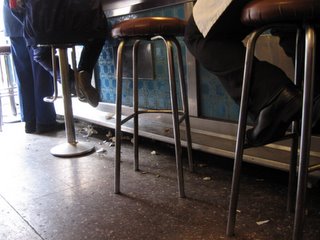 The floor of the eatery, littered with cigarillos in the midday sun.
The floor of the eatery, littered with cigarillos in the midday sun.
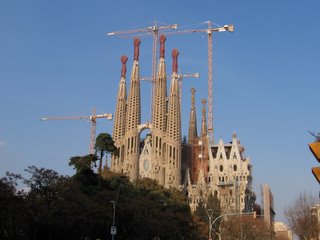 La Sagrada Familia: "If you only have time for one sightseeing outing in Barcelona, this should probably be it," according to Lonely Planet. Gaudi, then 31 years old, took it in 1884. It had been planned as a regular neo-Gothic structure to crush revolutionary thought in the day. But Gaudi took it and twisted it, making it run wild (you get the sense that the temple's alive, breathing, pulsing). Unfortunately, he died with only some of the primary construction complete. Some more towers went up in 1930, but in 1936 (when Orwell was fighting in the Spanish Civil War), anarchists came in and smashed everything. But, using photographs of old designs and plans, construction continued, and it's set to be done in 2020, though a bartender told us that it probably will be done the same time the Big Dig is done. When it's done, the central tower (of 12 -- one for each apostle) will stand at 170m high (the ones we climbed were about 14o)
La Sagrada Familia: "If you only have time for one sightseeing outing in Barcelona, this should probably be it," according to Lonely Planet. Gaudi, then 31 years old, took it in 1884. It had been planned as a regular neo-Gothic structure to crush revolutionary thought in the day. But Gaudi took it and twisted it, making it run wild (you get the sense that the temple's alive, breathing, pulsing). Unfortunately, he died with only some of the primary construction complete. Some more towers went up in 1930, but in 1936 (when Orwell was fighting in the Spanish Civil War), anarchists came in and smashed everything. But, using photographs of old designs and plans, construction continued, and it's set to be done in 2020, though a bartender told us that it probably will be done the same time the Big Dig is done. When it's done, the central tower (of 12 -- one for each apostle) will stand at 170m high (the ones we climbed were about 14o)
 Josep Subirachs did the sculpture in the front, going with his own creative style to make some jagged and stirring figures.
Josep Subirachs did the sculpture in the front, going with his own creative style to make some jagged and stirring figures. Talkin' bout stirring figures... (look at the guy behind the column, hugging it)
Talkin' bout stirring figures... (look at the guy behind the column, hugging it)
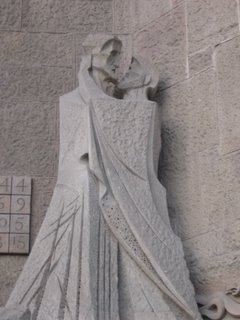 Kissing?
Kissing?
 The columns inside, designed to look like a forest.
The columns inside, designed to look like a forest. 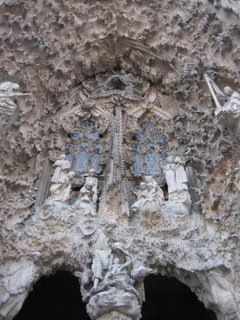 More sculptures. They depict the Stations of the Cross as they ascend the building.
More sculptures. They depict the Stations of the Cross as they ascend the building. The area of town, L'Eixample, started life mainly after the Civil War, expanding from a really limited Old City to the South. So from the heights, you see long lines that march on like anarchists into their mom's houses so they can have their military uniforms washed and eat baguette sandwiches filled with sausages spicy enough to rivet up some good revoltin' blood.
The area of town, L'Eixample, started life mainly after the Civil War, expanding from a really limited Old City to the South. So from the heights, you see long lines that march on like anarchists into their mom's houses so they can have their military uniforms washed and eat baguette sandwiches filled with sausages spicy enough to rivet up some good revoltin' blood.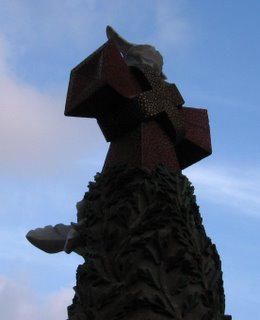 The cross is a big mosaic.
The cross is a big mosaic. OH MY GOD IT'S TOTALLY ANOTHER GHERKIN.
OH MY GOD IT'S TOTALLY ANOTHER GHERKIN.
 I'm just so amazed that two (maybe more) of these things exist in the world. The one in London was cool, but seeing that another one exists is like when I was so happy about coming up with "prose before hoes," then finding out that the Collegehumor boys made a t-shirt with that on it.
I'm just so amazed that two (maybe more) of these things exist in the world. The one in London was cool, but seeing that another one exists is like when I was so happy about coming up with "prose before hoes," then finding out that the Collegehumor boys made a t-shirt with that on it. Tay also loves the Gherkin.
Tay also loves the Gherkin.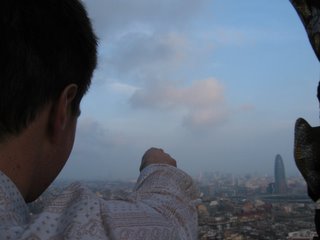 I'm beginning to think they're something like those monoliths in 2001: A Space Odyssey. They just start appearing and monkeys start hitting each other with shovels made from rocks and other monkeys' fingerbones.
I'm beginning to think they're something like those monoliths in 2001: A Space Odyssey. They just start appearing and monkeys start hitting each other with shovels made from rocks and other monkeys' fingerbones.
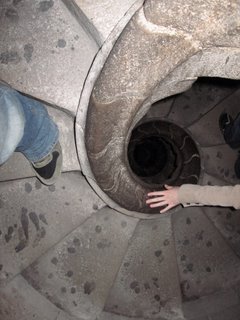 The staircase down, supposed to look like a shell.
The staircase down, supposed to look like a shell. Tay should have pictures taken from close. Me, from afar. Or in very dim lighting. Maybe not at all.
Tay should have pictures taken from close. Me, from afar. Or in very dim lighting. Maybe not at all.
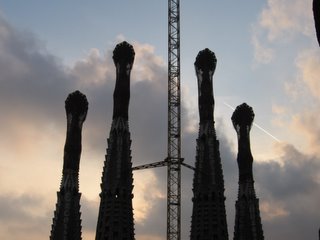
Wow, I'm watching the Super Bowl right now. Imagine instead of watching the wonderful commercials you're watching, we get to watch some turtle going after Diet Coke. And it occasionally cuts to this studio where this female analyst who looks like Jodie Foster is asking Philly Eagle LB Dhani Jones to explain how good the commercials are -- and if players can pay attention to the game in the locker room while the Rolling Stones are playing at halftime.
TOMORROW
The Arab Confrontation
Gaudi's Park (like an architectural amusement park)
The harbor
Sunset Pictures
Sangria & Tapas

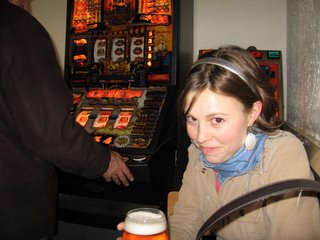
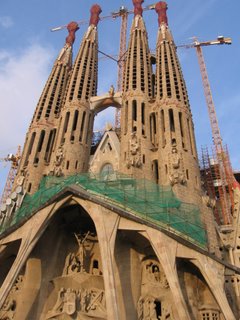


0 Comments:
Post a Comment
<< Home